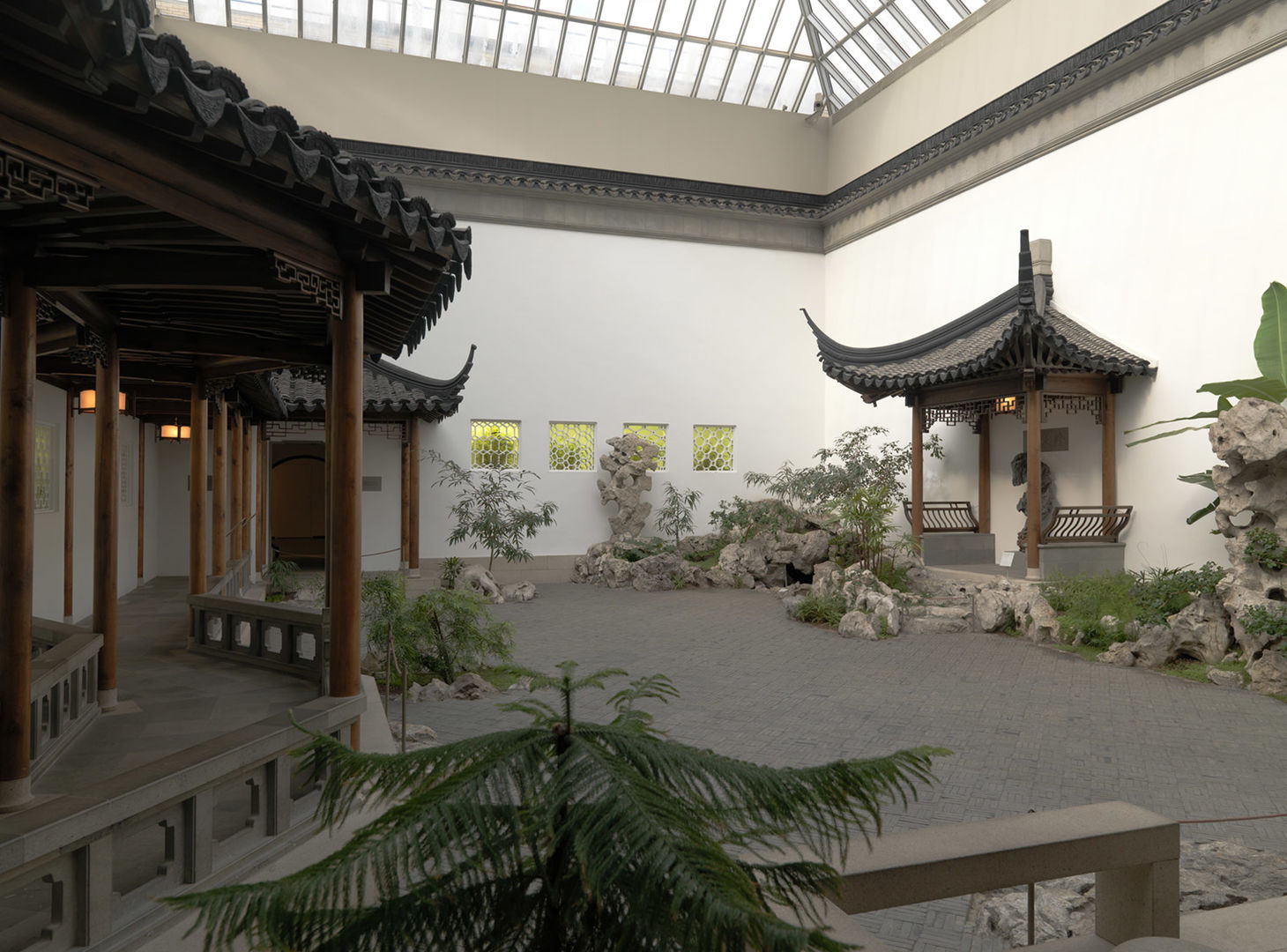The Astor Chinese Garden Court

The Astor Chinese Garden Court, 1981. Modeled on a Ming dynasty (1368–1644) scholar's courtyard in the Garden of the Master of the Fishing Nets, Suzhou. The Metropolitan Museum of Art, New York, Gift of the Vincent Astor Foundation, 1981
Collection Areas: Asian Art, Chinese Art
Subject Areas: English Language Arts, Geography, Visual Arts, World History
Grades: Elementary School, Middle School, High School
Topics/Themes: Communities, Art and the Environment
Goals
Students will be able to:
- identify ways traditional Chinese gardens embody the concepts of yin and yang through the harmonious arrangement of contrasting elements;
- recognize how material selection and design can be used to convey ideas about humans and the natural world; and
- use drawing, writing, and verbal description to communicate sights, sounds, and textures found in this landscape.
National Learning Standards
Visual Arts
NA-VA.9-12.3 Choosing and Evaluating a Range of Subject Matter, Symbols, and Ideas
NA-VA.K-12.4 Understanding Visual Arts in Relation to History and Cultures
NA-VA.K-12.6 Making Connections between Visual Arts and Other Disciplines
Geography
NSS-G.K-12.5 Environment and Society
World History
NSS-WH.5-12.5 Era 5: Intensified Hemispheric Interactions, 1000–1500 c.e.
NSS-WH.5-12.6 Era 6: The Emergence of the First Global Age, 1450–1770
Common Core State Standards
English Language Arts
CCSS.ELA-Literacy.CCRA.R.6 Assess how point of view or purpose shapes the content and style of a text.*
CCSS.ELA-Literacy.CCRA.W.3 Write narratives to develop real or imagined experiences or events using effective technique, well-chosen details, and well-structured event sequences.
*Art as text
Questions for Viewing
- In Chinese culture, the circle symbolizes the universe, and the square, which has sides facing the four cardinal directions, represents the earth. What do you notice about the way the garden entrance engages both of these shapes? What might this tell us about what lies inside?
- As you enter the garden, the architecture invites you to choose a path. Describe the similarities and differences each path offers. Why do you think the designer included multiple pathways?
- Observe visitors engaging this space. What do you notice about the way they move (e.g., their path, speed, and demeanor)? How does this compare to your experience moving through a grocery store or train station?
- Describe the materials featured in this space. What criteria do you think the designer had in mind?
- One of the most important considerations in traditional Chinese garden design from this period is the harmonious arrangement of elements expressing different aspects of yin (dark, void, soft, yielding, wet, cool) and yang (bright, solid, hard, unyielding, dry, hot). What contrasts come to mind as you explore this space? What do you see that makes you say that? Do you think the garden achieves a balance? Why?
- This environment was modeled after a courtyard garden constructed in China during the Ming dynasty (1368–1644). What strategies has the designer used to create a transition between the interior and exterior spaces? What does this environment suggest about the relationship between the human and natural worlds in this community?
Activity
Activity Setting: Museum
Materials: Paper, pencils, hard writing surface
Subject Areas: English Language Arts, Geography, Visual Arts
Duration: 30 minutes
Traditional Chinese gardens strive to create a sense of wandering through the landscape. Rock compositions bring to mind mountains and caves; miniature trees and bushes suggest ancient trees and forests; and small ponds represent vast rivers and oceans. Imagine you are flying above the scene; everything appears small and distant below. Choose a spot to "land" and describe the sights, sounds, and textures you might experience as you travel from this point to a nearby destination. Ask a partner to close his or her eyes and listen as you recount the journey orally or capture your experience by writing or drawing.
Resources
Department of Asian Art. "Chinese Gardens and Collectors' Rocks." In Heilbrunn Timeline of Art History. New York: The Metropolitan Museum of Art, 2000–. (October 2004)
Department of Asian Art. "Nature in Chinese Culture." In Heilbrunn Timeline of Art History. New York: The Metropolitan Museum of Art, 2000–. (October 2004)
Hammer, Elizabeth, and Felicia Blum. Nature Within Walls: The Chinese Garden Court at The Metropolitan Museum of Art. New York: The Metropolitan Museum of Art, 2003. Download the resource (PDF).
Keswick, Maggie. The Chinese Garden: History, Art and Architecture. Cambridge, MA: Harvard University Press, 2003.
Murck, Alfreda, and Wen Fong. A Chinese Garden Court: The Astor Court at The Metropolitan Museum of Art. New York: The Metropolitan Museum of Art, 1980.
Watch The Chinese Garden Court at The Metropolitan Museum of Art on YouTube.
Objects in the Museum's Collection Related to this Lesson
Elegant Gathering in the Apricot Garden, Ming dynasty, ca. 1437, after Xie Huan (Chinese, ca. 1370–ca. 1450). China. Handscroll, ink and color on silk, 14 3/8 x 94 3/4 in. (36.7 x 240.7 cm). The Metropolitan Museum of Art, New York, Purchase, The Dillon Fund Gift, 1989 (1989.141.3)
Xia Chang (Chinese, 1388–1470), Bamboo in Wind, Ming dynasty, ca. 1460. China. Hanging scroll, ink on paper, 80 1/4 x 23 1/2 in. (203.8 x 59.7 cm). The Metropolitan Museum of Art, New York, Edward Elliott Family Collection, Gift of Douglas Dillon, 1989 (1989.235.1)
Author: Claire Moore, The Metropolitan Museum of Art, 2010